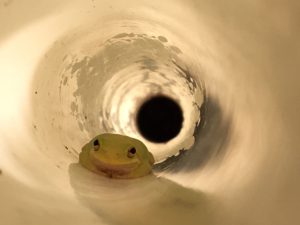Here in Florida we hear plenty about the invasive species that state battles every day. Pythons, lionfish, lizards, trees, vines, and even monkeys. But sometimes hunting for these invasive animals have their neat perks. Take hunting for the presence of Cuban Treefrogs.

Photo: Keith Wilkins
The invasive treefrogs entered the state at the southern end and have dispersed as far north as Gainesville. There have been reports of individuals in the panhandle but it is believed there are no established populations here. That said, it was recently discovered that a park near the Audubon Zoo in New Orleans has several hundred – maybe more. It is believed they hitched a ride on a load of plants sent there from south Florida. Loads of plants from south Florida arrive in the panhandle all the time – it could happen here as well. So, we ask residents to be vigilant and keep an eye for non-native species of all sorts.
To search for Cuban Treefrogs (CTF), you can place a 3’ section of 1.25-1.50” PVC pipe in the ground near your house where bushes and shrubs can be found. The treefrogs will seek these out during the daylight hours and can be examined for the presence of CTF’s.

Photo: Rick O’Connor
The cool perk?
Native treefrogs will do the same. It is pretty cool to observe them and determine which species you have. We have one living in one of our three pipes at the extension office. One volunteer near Perdido Key has had as many as 17 in one. The day I visited, she had numerous treefrogs in each of her PVC pipes. There are numerous guides you can use to identify the frogs you have captured and each volunteer who has found them in their pipes found the experience to be pretty cool.
How do you get them out of the pipe to get a good look at them?
Well, one of volunteers has come up with a neat method. She first pulls the PVC pipe from ground. Places a 1-gallon zip lock bag underneath the bottom opening of the pipe. Attached a sponge with the same diameter of her pipe to the handle of an old mop and covered this with duct tape. She SLOWLY depresses the sponge through the pipe and captures the treefrogs in the zip lock bag. Here you can easily observe what you have. If they are natives, take a few pictures, release them into your yard, and use a guide to identify what you have. Replacing the PVC pipe will soon attract the frogs once again.

Photo: Molly O’Connor
How do I know if I have the CTF?
Adult CTFs are much larger than our natives. Native treefrogs might reach 2”; the CTF can reach 5”. Smaller CTFs can be identified by the blue coloration of their skeleton through the skin as you look at the belly side of the animal. Also, the skin between the eyes of the CTF is fused to the skull – this is not the case with native treefrogs. If you do find a CTF, please contain it and call us here at the extension office.
We do several citizen scientist wildlife monitoring projects through our office. Though some involve searching for animals or plants we hope we do not find, and many times we do not, what we do find is pretty cool and makes the time spent worth it.
To learn more about setting pipes for frogs contact Rick O’Connor at roc1@ufl.edu
To learn more about other citizen science monitoring projects visit http://sfyl.ifas.ufl.edu/escambia/natural-resources/sea-grant/.
 0
0
